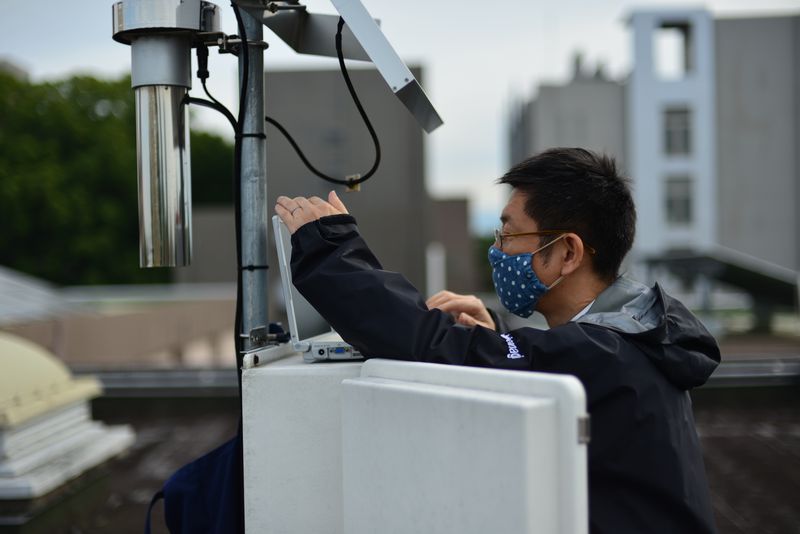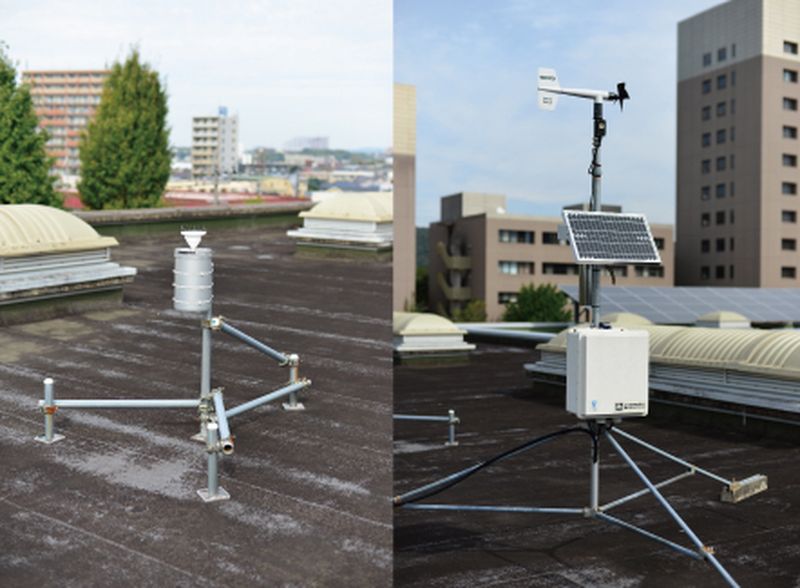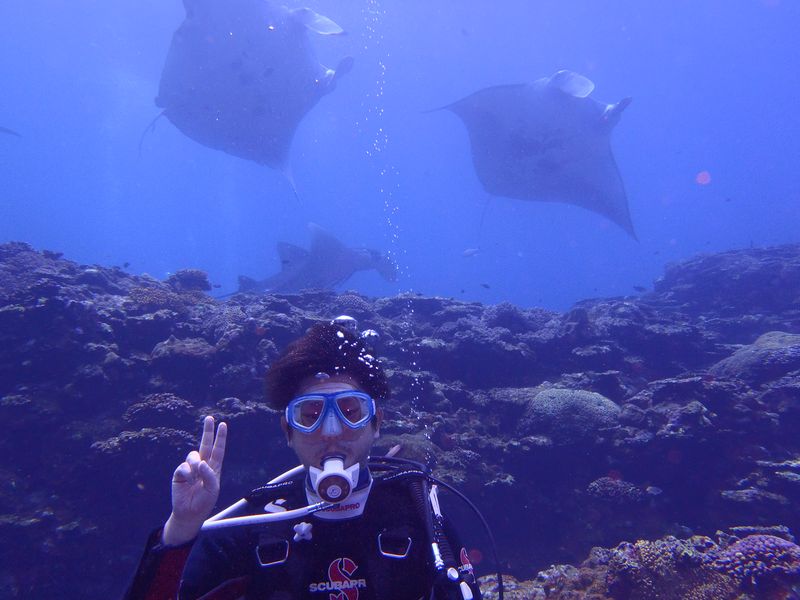Using stable isotopes in rainwater, Prof. Ichiyanagi identifies where rain comes from.

Prof. Ichiyanagi works in the field of isotope hydrometeorology. He studies water cycles in the atmosphere by measuring stable isotopes in rainfall samples. He is one of the few people in the world to explore this topic. We interviewed Prof. Ichiyanagi to find out more about his unique research.
Research to explore water cycles through stable isotopes
Interviewer (◆ hereafter): Please tell us about your research!
Prof. Ichiyanagi: My specialty is hydrometeorology, which is an interdisciplinary study between hydrology and meteorology. In Japan, hydrologists study mainly surface water and groundwater, while meteorologists study water circulation in the atmosphere.
I measure the stable isotopic compositions of hydrogen (H) and oxygen (O) in water (H2O), and apply to hydrology and meteorology. So, I call my research as “isotope hydrometeorology.” For example, stable isotopes in precipitation incorporated in a general circulation model (GCM), the origin of water vapor in the atmosphere can be estimated.
I measure the stable isotopic compositions of hydrogen (H) and oxygen (O) in water (H2O), and apply to hydrology and meteorology. So, I call my research as “isotope hydrometeorology.” For example, stable isotopes in precipitation incorporated in a general circulation model (GCM), the origin of water vapor in the atmosphere can be estimated.
◆ : Prof. Ichiyanagi, how long have you been measuring data?
Prof. Ichiyanagi: Since March 2015, I have been conducting meteorological observations at Kumamoto University. Every hour, precipitation amount, pressure, temperature, relative humidity, wind direction and speed are recorded. Two types of rain gauges are installed: one is rainwater storage and another is tipping backet. Collected rainwater samples are sent to IAEA (International Atomic Energy Agency) to measures the stable isotopic compositions and a radioactive Tritium every month.
IAEA publishes the precipitation isotope data around the world. Currently, only Kumamoto University conducts these observations in Japan.

Measurement equipment on the rooftop.
IAEA publishes the precipitation isotope data around the world. Currently, only Kumamoto University conducts these observations in Japan.

Measurement equipment on the rooftop.
Who I am now is due to chance encounters and luck
◆ : What motivated you to start this research?
Prof. Ichiyanagi: It was accidental. I feel like who I am now is due to chance encounters and luck.
While in my doctoral studies at Nagoya University, I used stable water isotopes in the field of hydrology. Before I got a PhD, I was hired by NIED (National Research Institute for Earth Science and Disaster Prevension) in Tsukuba City and I began research in meteorology for the first time. Later, I moved to the JAMSTEC (Japan Agency for Marine-Earth Science and Technology) to join a new research group to study large-scale water cycles using stable water isotopes. I had continuously studied atmospheric water cycles by analyzing stable isotopes in precipitation collected from overseas, especially in remote areas. These experiences have led to my current research.
My mentor researcher at JAMSTEC was well-known in the field of meteorological modeling. Unfortunately, he passed away before he had completed isotope-incorporated GCM. Soon after, I met an excellent young researcher and he permitted to use his innovative isotope model for my research. More than 10 years have passed since I came to Kumamoto University. My first student at Kumamoto University became a researcher, and we continue to investigate isotope studies together.
I truly feel blessed with chance encounters and good timing.

Left: Rain gauges to collect rainwater
Right: Meteorological equipment
While in my doctoral studies at Nagoya University, I used stable water isotopes in the field of hydrology. Before I got a PhD, I was hired by NIED (National Research Institute for Earth Science and Disaster Prevension) in Tsukuba City and I began research in meteorology for the first time. Later, I moved to the JAMSTEC (Japan Agency for Marine-Earth Science and Technology) to join a new research group to study large-scale water cycles using stable water isotopes. I had continuously studied atmospheric water cycles by analyzing stable isotopes in precipitation collected from overseas, especially in remote areas. These experiences have led to my current research.
My mentor researcher at JAMSTEC was well-known in the field of meteorological modeling. Unfortunately, he passed away before he had completed isotope-incorporated GCM. Soon after, I met an excellent young researcher and he permitted to use his innovative isotope model for my research. More than 10 years have passed since I came to Kumamoto University. My first student at Kumamoto University became a researcher, and we continue to investigate isotope studies together.
I truly feel blessed with chance encounters and good timing.

Left: Rain gauges to collect rainwater
Right: Meteorological equipment
Sharing the enjoyment of scuba diving with students
◆ : You are also in charge of the scuba diving club at Kumamoto University, right?
Prof. Ichiyanagi: I have enjoyed scuba diving for a long time. About two years after I came to Kumamoto University, I was asked to manage the scuba diving club. It is a lot of fun to go under the sea with students. At Kikai island, which is where we hold annual summer training camps, I became close to people working at scuba diving shops and at the hotel. They have been very nice to me and the students. Once the coronavirus pandemic calms down, I would like to go again next year.
The attraction of scuba diving is about “switching worlds.” When I look at amazing sea creatures under the beautiful ocean, I am immersed in a totally different world. My first diving experience was in Okinawa when I was a university student. I was moved by the existence of such a wonderful world.
Kyushu has many good scuba diving spots such as Amakusa in Kumamoto. Compared to the Honshu island of Japan, the color of ocean is different and it is less stressful because the water is warmer.
The scuba diving club accepts newcomers to scuba diving, so please feel free to join. You can aim to become an “independent scuba diver who can go under the sea all over the world.” You may even earn advanced licenses or pass the national qualification as a diver. Joining the scuba diving club will change your life.

A diving scene at “Manta Scramble” in Ishigaki Island
The attraction of scuba diving is about “switching worlds.” When I look at amazing sea creatures under the beautiful ocean, I am immersed in a totally different world. My first diving experience was in Okinawa when I was a university student. I was moved by the existence of such a wonderful world.
Kyushu has many good scuba diving spots such as Amakusa in Kumamoto. Compared to the Honshu island of Japan, the color of ocean is different and it is less stressful because the water is warmer.
The scuba diving club accepts newcomers to scuba diving, so please feel free to join. You can aim to become an “independent scuba diver who can go under the sea all over the world.” You may even earn advanced licenses or pass the national qualification as a diver. Joining the scuba diving club will change your life.

A diving scene at “Manta Scramble” in Ishigaki Island
The importance of making good friends and cherishing your friendships
◆ : Please give a message to students.
Prof. Ichiyanagi: I have been blessed with good friends, who helped me when I was in trouble. Of course, you have to try your best, but when it’s too much to handledo on your own, your “good friends” willingly lend you a hand. You should cherish these friendships.
